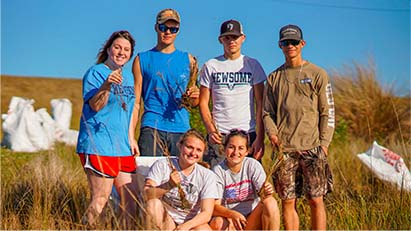
Supporting Youth Leadership in Environmental Research
By Hira Ahmad
Youth advocacy for coastal resilience and restoration has created positive impacts far beyond the environment. Reverberations of the young generation’s hopes have inspired individuals worldwide to act and hold accountable systems which have put both their own and by extension, all of our futures in jeopardy. While stories of youth acting in terms of policy and advocacy receive more regular coverage, youth involvement in research and restoration, and conservation efforts have flown under the radar until more recently. Emphasizing the contributions of youth within research and elevating these stories is a way to support shifts within research that have historically relied on the input of elders.
Supporting youth efforts in environmental research through citizen science has become widely used and extremely beneficial in bolstering meaningful community engagement. Having a more comprehensive understanding of best practices surrounding including youth in these efforts is crucial for improving the applicability of a study and its relevance to their unique interests and visions of their future. Not only this, but creating citizen science practices that incorporate youth interests and input more frequently is also a way to increase the visibility of their efforts within academic research. In fact, a 2022 study emphasized the importance of involving youth in participatory research, including benefits to young people gaining experience with researchers and experts whose roles and positions they may initially have viewed as inaccessible.
Not only do youth benefit from these interactions, but the research outcomes do as well. There is a limited understanding of how health, climate change, and youth engagement are related. Many studies fail to bridge gaps between these understandings to promote long-standing change that can be supported by youth involvement. The authors of this study state, Some policies factor in the health impacts of climate change on young people or mention the roles of young people in protecting the environment, but most still see young people as a vulnerable group in a changing climate. The policies provide little details on how young people can act on climate and health issues.
Connecting the experiences of those most vulnerable to climate change impacts and providing them with agency to advocate for changes that would benefit them is a critical connection point for ongoing and future research.
While international organizations and research institutes have been leading the way for youth involvement, the United States is following suit, and government agencies (EPA, National Parks Service, NOAA, and the Department of the Interior) are prioritizing integrating youth perspectives and expertise into agency-wide efforts. However, ensuring that such integration is done equitably, with diverse perspectives and priorities at the forefront, is a larger-scale issue.
Historically, powerful organizations and entities have relied on the perspectives of the most privileged voices in our society. Integrating youth into conversations of climate and conservation requires a commitment to amplifying voices that have not been heard frequently. Creating solutions that will benefit communities most affected by environmental degradation and hazards requires the input of their youth. However, understanding how to create space for these contributions is an important consideration for organizations and agencies hoping to do so.
In response to these considerations, the United Nations have discussed guidelines for equitable youth engagement in a paper on elevating engagement without tokenism. In this context. tokenism refers to the inclusion of youth voices to fulfill quotas and requirements, or as a simple tick box to be checked. This attitude disregards the profound influence of youth perspectives on climate research, policy, and initiatives.
Additionally, this study includes a robust focus on youth participation as a human right, and meaningful youth participation is about sharing power in youth-adult partnerships and decision making.
Creating structures and considerations through which institutions, organizations, and individuals can begin to think about meaningfully engaging youth in environmental work is a significant step in establishing equity in climate and environmental decision-making more broadly. The recommendations provided by the United Nations emphasize; supporting inclusive procedures which ensure representation, providing access to networking and financial opportunities for youth development, promoting the interconnectedness of other issues affecting youth with environmental concerns, and safeguarding youth empowerment.
Keeping these recommendations and others in mind when designing initiatives for youth involvement is an opportunity for organizations to further the relevance and longevity of their environmental projects and programs. Youth bring invaluable insights to resilience and restoration efforts worldwide, including advocating for emergency action on climate change, to restoring local waters through hands-on efforts, as well as continuing to learn and develop their understanding of environmental issues. Through these opportunities and countless others, young people are leading the way with a tenacity few other groups of individuals have been able to replicate.
Youth activism and development in the climate sector rely upon the attitudes and actions of elders in our society. Providing funding for youth-led organizations, giving them the opportunities to participate in a formal position, recognizing their political influence, and embracing the energy that they bring to these conversations are a few ways that Time Magazine has recommended we nurture climate activism by youth – We must infuse the entire climate movement with the urgency shown by youth leaders… we can get there as an intergenerational movement if we take action to put youth climate leaders where they can help us the most- right up front.
 Hira Ahmad is a Master’s Candidate at the University of Michigan School of Environment and Sustainability studying Ecosystem Science and Management as well as Environmental Justice. She is particularly interested in exploring conservation through an equity-centered lens focusing on water quality issues in the Great Lakes Region.
Hira Ahmad is a Master’s Candidate at the University of Michigan School of Environment and Sustainability studying Ecosystem Science and Management as well as Environmental Justice. She is particularly interested in exploring conservation through an equity-centered lens focusing on water quality issues in the Great Lakes Region.
